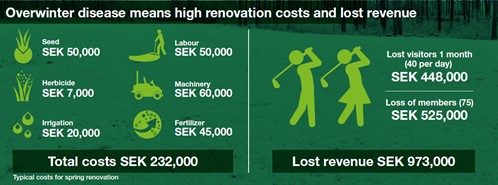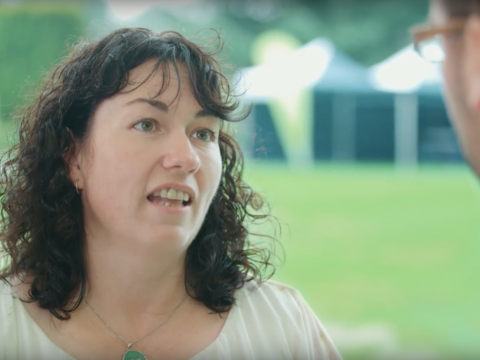Greencast Sweden - CUT THE COST OF SPRING RESTORATION

The damaging effects of overwinter attacks of Microdochium Patch (Fusarium Snow Mould) can prove very costly to repair in the spring - as well as losing valuable income when opening the course is delayed.
Preventing winter disease attacks can significantly cut the cost and time spent on spring restoration, according to Syngenta Nordics Business Manager, Lars Tveter. Furthermore, early opening attracts more players to the course to generate revenue - along with greater player satisfaction from good playing conditions that can keep them coming back all season long.
He calculates that costs for a course restoring fairway turf cover, involving reseed of 20% of area and 40% over sown - which can be frequently encountered in Nordic winter conditions - could amount to over 230,000SEK a year. "That includes time that would be better spent on course preparations, along with a carbon footprint environmental cost of additional fertiliser, fuel and irrigation," he added.

More significantly, if opening is delayed for a month the lost green fees from 40 visitors a day could amount to around 450,000SEK, along with 10% of members moving to other clubs that are open potentially costing over 500,000SEK in lost revenue.
"It clearly makes sound economic sense to utilise new turf agronomy techniques that can build turf strength to be healthier and greener going into the winter, and better able to withstand damage from frost and disease," advised Lars.
"Trials have shown that includes appropriate nutrition and a season-long Primo Maxx programme that can help to build up carbohydrate reserves and improve turf health, combined with well-timed Medallion TL fungicide applications to prevent disease attacks."
Last year Magnus Ljungman, Course Manager at the 36-hole Banchef Österåkers Golf Course near Stockholm sprayed all the greens of the East Course with Medallion TL in November, but rain prevented application on the West Course. Over 50cm of snow fell two days after application - and stayed on the ground for 144 days.
With the blanket of snow creating the ideal conditions for Michrodchium Patch, Magnus feared the worst when the snow started to melt. "On the West Course the greens were in a terrible state - with up to 80% turf loss; I had never seen so much disease in all my years of greenkeeping," he recalled.
"On the East Course, however, the greens were completely clean and free of disease. The snow had also proteceted against frost damage, so we had surfaces ready for play far earlier than we have had in the past."
A further result of the damage on the East Course meant Magnus and the greenkeepeing team spent an extra 600 hours of overtime on remedial restoration work, along with costly additional inputs of extra fertilser and irrigation. Even then, the course opening was delayed by a month - missing out on valuable early income in greens fees and associated player spend - and he was still reporting seeing problems in mid-summer.
"This season's extreme disease damage to the greens has cost us a lot of money, and many sleepless nights of concern," he added. "It is something that we really do not want to experience again. I am going to treat the greens with at least two fungicide treatments before next winter."
For optimum disease control under Nordic winter conditions, Lars Tveter advised Medallion TL should be applied when soil conditions have cooled below 7°C and ahead of the first snow cover.
"Earlier applications of Medallion TL Contact+ activity can give significant benefits, especially when treating greens and tees with a two-spray programme," he added. "Early treatment will reduce pathogen numbers on turf and in the thatch, which will lessen disease pressure and lower the risk of infection.
"Protection is locked onto the leaf and crown of the plant which, combined with the gradual uptake and movement of Medallion TL with any leaf growth, prevents disease infection and has been shown to give exceptional long-lasting results."
Greenkeepers and turf managers can receive up to date advice on control of winter disease - along with a wealth of other valuable turf management advice and information - on the website www.greencast.se






